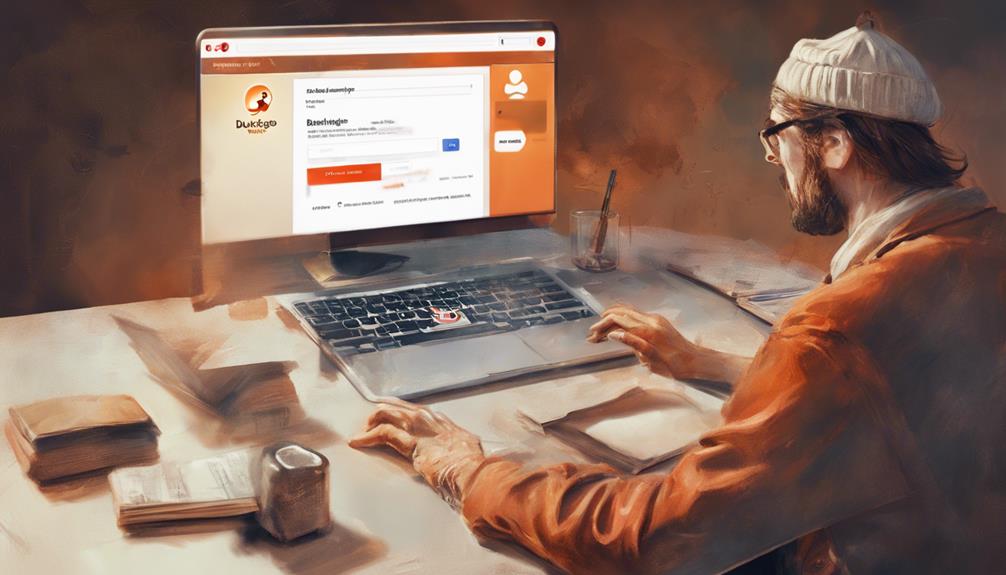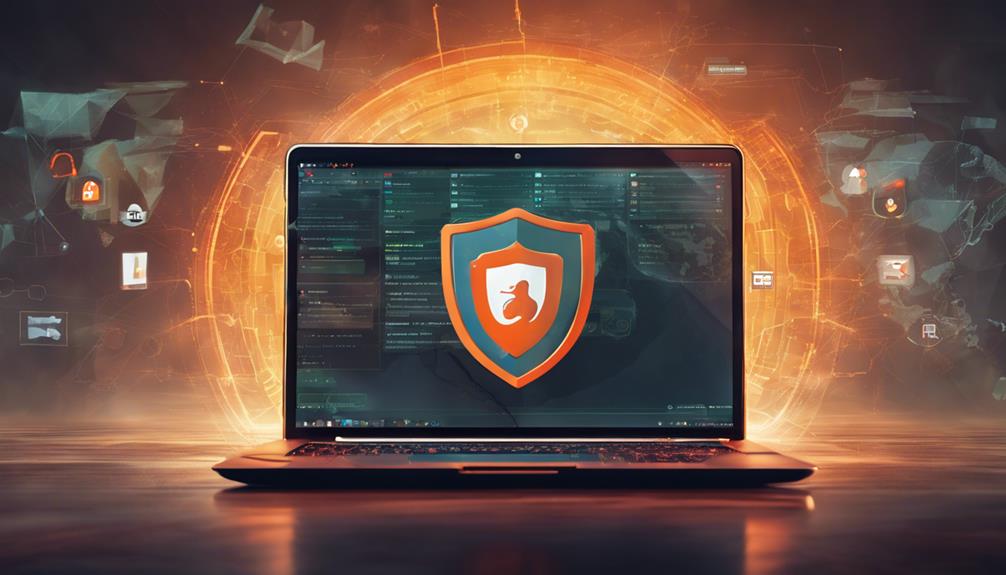DuckDuckGo, although prioritizing privacy, faces risks from outdated systems and phishing threats. Users remain susceptible to malware and cyber attacks by clicking on search results. Microsoft trackers on third-party pages accessed through DuckDuckGo heighten vulnerabilities. Incorporating antivirus software is crucial for protection. VPNs encrypt connections, shielding against cyber threats, especially on public networks. Caution is necessary with search results to avoid potential hazards. Complementing DuckDuckGo with robust security measures fortifies against tracking and malware risks. The hidden dangers and privacy concerns underscore the need for enhanced security protocols to safeguard online activities.
Key Takeaways
- DuckDuckGo is not immune to security risks like phishing and malware due to potential vulnerabilities.
- Outdated systems can expose users to cyber threats while using DuckDuckGo.
- Microsoft trackers on DuckDuckGo may pose hidden dangers, requiring additional security measures.
- Supplement DuckDuckGo with antivirus software to prevent malware threats.
- Incorporating a VPN enhances privacy and security when using DuckDuckGo.
Potential Browser and OS Vulnerabilities
Browser and operating system vulnerabilities present significant risks to DuckDuckGo users, demanding diligent attention to security measures.
Browser vulnerabilities, if not addressed promptly through security patches, can expose users to malicious attacks by hackers aiming to exploit these weaknesses. Similarly, outdated operating systems with security flaws provide an entry point for cybercriminals to compromise user data on DuckDuckGo, putting sensitive information at risk.
Phishing attacks, a common tactic used by hackers, can take advantage of browser or OS vulnerabilities to deceive users into disclosing confidential details while using the search engine. Additionally, malware designed to exploit these vulnerabilities can infiltrate devices, leading to the compromise of user privacy on DuckDuckGo.
To mitigate these risks, it is important for users to regularly update their browsers and operating systems, alongside using robust security software that can help safeguard against potential threats targeting DuckDuckGo users.
Risks of Clicking on Search Results

Clicking on search results in DuckDuckGo exposes users to various potential risks, including malware, phishing sites, and malicious content. Hackers exploit vulnerabilities in websites linked in search results to compromise user devices and steal sensitive information. This poses a significant threat as cyber attacks can result in data breaches and financial losses for individuals.
While DuckDuckGo prioritizes user privacy by preventing tracking, it does not provide immunity against malware or malicious websites. Users must exercise caution when interacting with search results to mitigate the risk of falling prey to hacker threats.
To enhance protection, combining DuckDuckGo with security measures such as antivirus software and Virtual Private Networks (VPNs) is advisable. Antivirus software can detect and prevent malware infections, while VPNs encrypt internet connections to safeguard sensitive data from potential breaches.
Malware Installation Threats

DuckDuckGo's privacy-focused approach does not shield users from malware risks, necessitating a closer examination of the potential threats.
Understanding how malware can infiltrate systems, implementing effective prevention strategies, and recognizing indicators of possible malware installation are vital aspects to explore in safeguarding one's online security while utilizing DuckDuckGo.
Malware Risks Explained
Users should be wary of potential malware installation threats while browsing on DuckDuckGo, as the search engine does not offer built-in antivirus protection. Recent concerns have been raised regarding the presence of Microsoft trackers on third-party pages accessed through DuckDuckGo, potentially exposing users to security risks and malware threats.
While DuckDuckGo does automatically block most trackers, the allowance of Microsoft trackers has sparked questions about browsing safety and hidden dangers on the platform.
To enhance protection against malware risks, utilizing antivirus software is vital when using DuckDuckGo, as the search engine lacks this built-in safeguard. It is imperative for users to be proactive in implementing additional security measures to mitigate potential threats and safeguard their devices from malicious software.
Prevention Measures Discussed
To mitigate the risks of malware installation threats while using DuckDuckGo, it is imperative for users to proactively implement preventive measures. Given DuckDuckGo's focus on privacy protection and secure search, users should be aware of potential malware risks that could compromise their online safety. One key concern is the presence of Microsoft trackers on third-party pages accessible through DuckDuckGo, which may pose targeted search risks to users. While DuckDuckGo does block most trackers, past instances have shown that Microsoft trackers have been allowed, highlighting the hidden risks users face.
To enhance their security posture, users are advised to supplement DuckDuckGo with antivirus protection. This additional layer of defense can help safeguard against malware threats that may still lurk on suggested pages. By taking these prevention measures, users can better protect themselves while enjoying the privacy-centric benefits of DuckDuckGo's search engine.
| Prevention Measures | Description |
|---|---|
| Antivirus Protection | Supplement DuckDuckGo with antivirus software to guard against potential malware risks. |
| Privacy Protection | Stay vigilant about privacy protection features and take necessary steps to secure search. |
| Secure Search | Be cautious while browsing to avoid falling victim to targeted search threats. |
Warning Signs Identified
Amid the landscape of potential malware installation threats, notable warning signs have been identified while utilizing DuckDuckGo as a search engine. While DuckDuckGo prioritizes privacy and blocks most trackers to prevent search leakage and protect user data, it does not offer built-in antivirus protection. This omission leaves users vulnerable to malware risks when exploring suggested pages.
Recent concerns have surfaced regarding Microsoft trackers present on third-party pages accessed through DuckDuckGo, raising questions about data tracking and collection. Even though DuckDuckGo aims to safeguard personal information, the visibility of Microsoft trackers has sparked apprehension about the thoroughness of its security measures.
In the online world where threats lurk, users must remain vigilant and consider additional security measures beyond what mainstream search engines provide. The absence of antivirus protection in DuckDuckGo underscores the importance of user awareness and proactive steps to shield against potential malware installations, especially when traversing the vast expanse of the internet.
Importance of VPNs for Protection

Utilizing a VPN while browsing on DuckDuckGo is vital for bolstering your online security and safeguarding your privacy. VPNs play an important role in encrypting your internet connection, shielding your data from potential cyber threats.
VPNS for Online Security
In today's digital landscape, utilizing VPNs for online security has become essential in safeguarding sensitive data and protecting against cyber threats. VPNs, or Virtual Private Networks, create encrypted connections that shield browsing activity from hackers seeking to exploit vulnerabilities.
By masking IP addresses, VPNs add an extra layer of security, reducing the risk of cyber attacks and unauthorized access to personal information. Particularly when using public Wi-Fi networks, where data breaches are common, employing a VPN is vital for maintaining online security.
The use of a VPN in conjunction with DuckDuckGo not only enhances privacy but also ensures that browsing activity remains hidden and secure. This anonymity online makes it significantly more challenging for hackers to track and target individuals while they navigate the internet.
Therefore, incorporating a VPN into one's online security measures is a fundamental step in safeguarding against potential threats and maintaining a secure digital presence.
Privacy Benefits of VPNS
Securing online privacy and data protection, VPNs play a pivotal role in safeguarding sensitive information from potential cyber threats.
Privacy Benefits of VPNs:
- Encryption of Online Activities: VPNs encrypt online activities, effectively protecting users from hackers attempting to intercept sensitive data.
- IP Address Concealment: They hide IP addresses, making it difficult for hackers to trace and target specific users, enhancing online privacy and security.
- Secure Browsing on Public Wi-Fi: VPNs are essential for secure browsing on public Wi-Fi networks. By routing internet traffic through secure servers, they provide an extra layer of protection against hackers and cybercriminals, safeguarding users from potential hacking attempts.
Hidden Risks of Using DuckDuckGo

Using DuckDuckGo comes with hidden risks that users should be aware of to protect their privacy and security effectively. While DuckDuckGo emphasizes privacy and security, users are not entirely shielded from potential hacker threats. Hackers may exploit vulnerabilities in DuckDuckGo's infrastructure or target unsuspecting users through phishing attempts and malicious links. These risks could lead to unauthorized access to user data or exposure to potentially harmful content on third-party websites.
To mitigate these potential threats, users must exercise caution when interacting with search results and advertisements on DuckDuckGo. Clicking on unfamiliar links or sharing sensitive information can make users susceptible to hacking attempts. Implementing additional security measures such as using VPNs, antivirus software, and practicing secure browsing habits can enhance protection against these hidden risks.
User Caution With Search Results

Exercising caution is essential when engaging with DuckDuckGo search results to mitigate potential risks of encountering harmful websites. Users should carefully evaluate the suggested search results before clicking on links to avoid landing on potentially harmful websites that could expose them to malware.
Despite DuckDuckGo's strong stance on privacy and tracking prevention, users remain vulnerable to malware when interacting with third-party websites linked from search results.
To stay safe while browsing, users should:
- Verify Links: Check the URLs of search results before clicking to confirm they lead to reputable websites.
- Avoid Suspicious Sites: Refrain from clicking on links from unfamiliar or suspicious websites to reduce the risk of encountering malware.
- Stay Informed: Regularly update antivirus software and stay informed about potential risks associated with Microsoft trackers and other malicious entities lurking on the web.
Privacy Concerns With Duckduckgo

Despite DuckDuckGo's emphasis on privacy protection, concerns have surfaced regarding potential privacy vulnerabilities related to the handling of Microsoft trackers and the risk of exposure to malware. While DuckDuckGo generally blocks trackers to safeguard user privacy, the temporary allowance of Microsoft trackers has raised eyebrows within the online community. This move has sparked questions about the extent to which user data might have been accessed during this period.
It is essential for DuckDuckGo users to remain cautious as the platform's privacy-focused approach does not shield them entirely from online threats like hackers, malware, and phishing attacks. To bolster their defenses, users are advised to complement DuckDuckGo with robust antivirus software to mitigate potential risks effectively.
In the digital landscape where hidden risks lurk, staying vigilant and proactive in safeguarding user privacy is paramount, emphasizing the need for enhanced security measures to counter evolving cyber threats.
Enhanced Security Measures Needed

Enhancing security measures is imperative for safeguarding user data and devices while utilizing DuckDuckGo's privacy-focused search engine.
To enhance security and protect against potential threats such as malware and phishing attacks, users can take the following measures:
- Utilize a VPN: Employing a Virtual Private Network (VPN) along with DuckDuckGo can add an extra layer of security by encrypting internet traffic and masking IP addresses, making it harder for hackers to intercept sensitive information.
- Practice Safe Browsing Habits: Users should exercise caution when clicking on links from search results and avoid downloading unknown files. Being vigilant about suspicious links can prevent falling victim to phishing attacks or inadvertently downloading malware.
- Maintain Updated Antivirus Software: Regularly updating antivirus software is vital to detecting and removing potential malware threats that could compromise the security of devices while browsing with DuckDuckGo.
Protecting Against Tracking and Malware

Implementing robust strategies to combat tracking and malware is vital in maintaining online security while utilizing DuckDuckGo's privacy-focused search engine. Although DuckDuckGo blocks most trackers, it is important to note that some, such as Microsoft trackers, may still slip through, potentially compromising users' privacy.
Additionally, users can encounter malware on suggested pages, despite DuckDuckGo's efforts to enhance privacy measures. It is essential to highlight that DuckDuckGo lacks built-in antivirus protection against malware threats, unlike some traditional search engines.
Recent concerns have emerged regarding the presence of Microsoft trackers on third-party pages accessed through DuckDuckGo, emphasizing the importance of staying vigilant about online safety and internet security. While DuckDuckGo offers enhanced privacy features, users must remain cautious of the hidden risks associated with trackers and malware, taking proactive steps to safeguard their online activities.
Frequently Asked Questions
Is Duckduckgo Safe From Hackers?
DuckDuckGo is a secure search engine that prioritizes user privacy and data protection. Its robust encryption, lack of personal data tracking, and proactive security measures reduce the risk of hackers gaining unauthorized access to sensitive information.
Is There a Downside to Using Duckduckgo?
While DuckDuckGo offers enhanced privacy, its lack of built-in antivirus protection exposes users to potential malware risks. Users must remain vigilant and augment DuckDuckGo with additional security measures like strong passwords, VPNs, and antivirus software.
Can the FBI See What I Search on Duckduckgo?
DuckDuckGo's strong privacy measures, including not logging user searches or personal data, may impede the FBI's ability to directly view specific search queries without proper legal authorization, such as a court order or subpoena.
Why Should I Use Google Instead of Duckduckgo?
Google offers an extensive range of services beyond search, enhancing productivity and convenience. Its advanced algorithm provides tailored results, capturing a vast market share. Users seeking integrated solutions and robust features may find Google more suitable than DuckDuckGo.
Conclusion
To wrap up, it is crucial for users of DuckDuckGo to be mindful of the hidden risks associated with using this search engine, such as potential browser vulnerabilities, malware installation threats, and privacy concerns.
By exercising caution with search results, implementing enhanced security measures, and utilizing VPNs for protection, individuals can better safeguard themselves against tracking and malware.
It is vital to remain vigilant and proactive in mitigating these risks to guarantee a safer online browsing experience.









